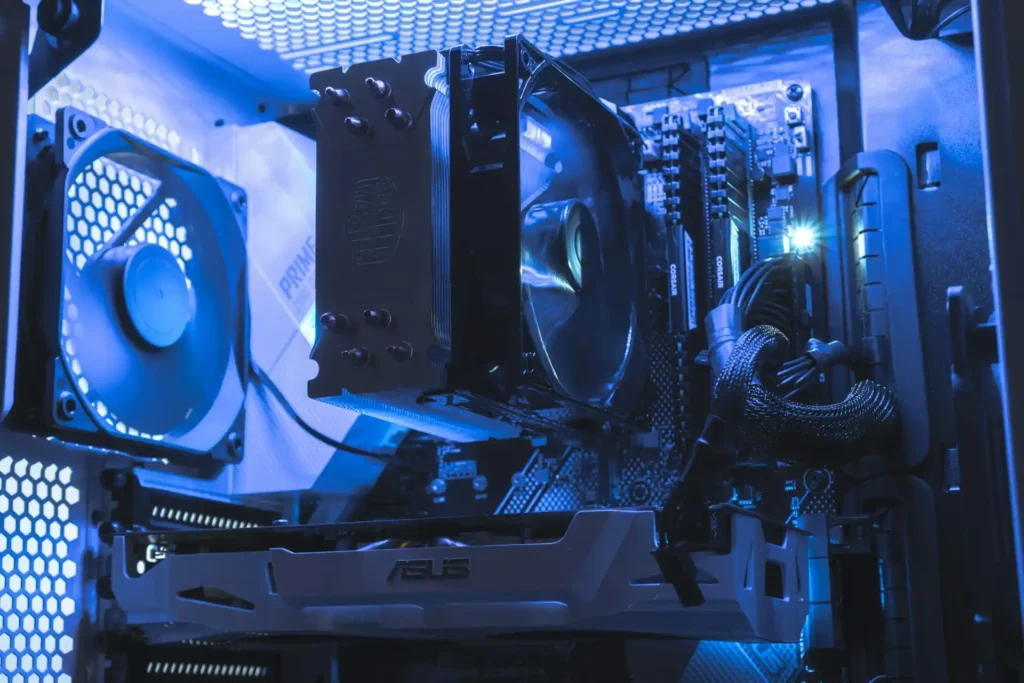So you’ve decided to build your own rig—whether it’s a budget gaming PC or a high-end powerhouse. Nice. Before you start throwing money at the shiniest components or getting caught up in benchmark wars, let’s talk about the real technical stuff that actually matters.
This isn’t another “just buy expensive parts” guide. We’re going deep on compatibility, performance bottlenecks, and how to avoid the mistakes that’ll have you posting “why is my new build underperforming?” threads later.
Now—time to get your parts together.
Whether you want to go full DIY and hand-pick each component or just tweak a pre-built list from a PC builder site, both routes are fine. Just don’t skip the boring-sounding-but-totally-critical stuff. Set a budget, figure out what games or software you actually plan to run, and build around that. People often start backwards—buying parts first, then trying to force them into a build that doesn’t really make sense. That’s how you end up with a killer GPU bottlenecked by a potato CPU, or RAM that doesn’t even boot with your motherboard.
So yeah—start with a plan, not a shopping cart.
Before you hit “checkout,” make sure everything plays nice together. Every single part—CPU, motherboard, RAM, PSU, even your damn case—needs to be compatible. PCPartPicker is your best friend here. You don’t want to find out your fancy new cooler blocks a RAM slot or your power supply is 150W short of what your GPU needs.
Also, don’t blow your whole budget upfront. It’s totally okay to leave some upgrade room. Grab a mid-tier GPU now, then upgrade later once prices drop or when your needs change. Gaming builds aren’t carved in stone—you can evolve the setup over time.
Here’s the core checklist:
- CPU (Processor)
- GPU (Graphics Card)
- Motherboard
- RAM (Memory)
- Storage (SSD/HDD)
- PSU (Power Supply)
- Cooling (Air or Liquid)
- Case (with airflow that doesn’t suck)
- OS (Windows, Linux, your call)
- Peripherals (monitor, keyboard, etc.)
Now, if you’re just starting with a budget gaming PC, here’s a solid entry-level combo that makes sense and won’t choke on modern titles:
 | Intel® Core™ i7-14700KF | $313.31 on Amazon | |
 | MSI MPG Z790 EDGE LGA 1700 6Gb/s DDR5 ATX Motherboard | $202.57 on Amazon | |
 | MSI GeForce RTX 3050 Ventus | $299.24 on Amazon | |
 | G.SKILL Trident Z5 RGB Series DDR5 RAM 32GB | $97.99 on Amazon | |
 | Seagate BarraCuda 2TB Internal | $64.99 on Amazon | |
 | Samsung 990 PRO SSD 1TB PCIe 4.0 M.2 2280 | $99.99 on Amazon | |
 | Antec Flux Wood, 5 x PWM Fans Included | $119.99 on Amazon | |
 | Cooler Master MasterLiquid 360L | $89.99 on Amazon | |
 | Corsair HX1500i (2023) 1500 W 80+ | $478.99 on Amazon |
Is this technically a “budget gaming PC” setup? Sort of—but the price-to-performance ratio here makes sense if you’re aiming for smooth gameplay without selling a kidney.
However, if you’re going all-in and building a high-end beast, we’ve already got you covered—scroll down for the full setup with parts that’ll handle anything you throw at them.
 | AMD Ryzen™ 9 7950X3D 16-Core, 32-Thread | $689.99 on Amazon | |
 | Corsair H115i RGB Platinum AIO Liquid CPU Cooler | $149.00 on Amazon | |
 | ASRock X670E AMD Processors Motherboard | $504.80 on Amazon | |
 | G.SKILL Trident Z5 DDR5 RAM 64GB | $234.99 on Amazon | |
 | Seagate 4TB HDD, 3.5" 6Gb/s, 5400RPM, 256MB | $84.99 on Amazon | |
 | Samsung 990 Pro 2 TB M.2-2280 | $149.99 on Amazon | |
 | MSI GAMING TRIO OC GeForce RTX 5090 | $3,199.00 on Amazon | |
 | Antec C8 Wood ATX Full Tower Case | $119.99 on Amazon | |
 | Corsair HX1500i (2023) 1500 W 80+ | $478.99 on Amazon |
PC Building Guide:
Alright, now that we’ve covered both budget and high-end builds, let’s talk about the actual components—what they do, what to look for, and what pitfalls to avoid. This is where most new builders either get overwhelmed or just guess their way through. Don’t be that person googling “why does my PC keep rebooting under load” at 2 AM. A little knowledge here saves a lot of headaches later. So yeah, let’s break it down—piece by piece.
CPU: Your System’s Decision Maker
The CPU handles everything your GPU doesn’t, which is more than you might think. Game logic, physics calculations, background processes, and feeding data to your graphics card all happen here. Don’t just look at core counts and clock speeds like they’re Pokémon stats.
Socket compatibility is non-negotiable
LGA1700 for Intel 12th/13th/14th gen, AM5 for AMD Ryzen 7000 series. Get this wrong and you’ve got expensive paperweights. But here’s what really matters for gaming performance: Single-core boost clocks and IPC (instructions per clock). A CPU that can hit 5.2GHz on one core will outperform a CPU stuck at 4.8GHz in most games, even if the slower one has more cores.
Those extra cores aren’t useless, though. Modern games are getting better at using 8+ threads, and if you’re streaming or running Discord, Spotify, and Chrome while gaming, those extra cores handle background tasks so your game threads stay happy. The sweet spot for most gamers is 6-8 cores with good single-core performance.
Here’s the technical bit most people miss
Boost behavior varies between chips. Intel’s 13700K might advertise a 5.4GHz boost, but that’s for light workloads on one core. Under gaming loads, it’ll settle around 5.1GHz on all performance cores. AMD’s 7700X is more conservative with advertised clocks but tends to hold them longer under sustained loads.
Cache matters too, especially L3 cache. Think of it as a buffer between your CPU cores and system RAM. More cache means fewer trips to slower system memory. This is why AMD’s X3D processors with extra cache dominate in many games despite lower clock speeds.
Motherboard: The Foundation Everything Else Depends On
Your motherboard isn’t just a place to plug things in. It’s the communication hub for your entire system, and cheap boards will bottleneck expensive components. The chipset determines what features you get – PCIe lanes, overclocking support, USB ports, and how many high-speed storage devices you can run simultaneously.
VRM
VRM quality is where boards really separate themselves. Those small components around your CPU socket regulate power delivery. Cheap VRMs with inadequate cooling will throttle your CPU when it tries to boost, especially under sustained loads. Look for boards with at least a 12+2 phase design for high-end CPUs. The power stages should handle 50+ amps each. Dr. MOS integrated designs typically run cooler and more efficiently than discrete MOSFET setups.
Memory
Memory support gets tricky with DDR5 for a budget gaming pc. Just because a board lists DDR5-6400 support doesn’t mean it’ll run stably with four sticks populated. High-speed memory is technically overclocking, and stability depends on your CPU’s memory controller, the specific RAM kit, and how many slots you fill. Always check the QVL (Qualified Vendor List) for your exact motherboard and RAM combination.
Pro tip
Two memory sticks will almost always be more stable than four at high speeds. The memory controller has an easier time driving two DIMMs, and you leave room for future upgrades.
RAM: Speed vs Latency vs Stability
DDR5 is the current standard, but it’s not just about raw speed numbers. Memory timings matter as much as frequency. The relationship between speed and latency determines real-world performance. A kit running DDR5-6000 with CL36 timings often outperforms DDR5-6400 with CL40 timings because the actual latency is lower.
Here’s the math
Real latency = (CL / Frequency) × 2000. Lower numbers are better. This is why tight timings on slightly slower memory can beat loose timings on faster memory.
Intel systems typically peak performance around DDR5-6000 to DDR5-6400. Going higher often requires looser timings that negate the speed advantage. AMD systems are a bit more forgiving with higher speeds due to how the Infinity Fabric connects CPU dies, but the same timing principles apply.
Dual channel is mandatory
Running single-channel memory cuts gaming performance by 15-30% in CPU-limited scenarios. Your memory controller needs both channels to feed data to your CPU cores efficiently. Think of it like having two lanes instead of one on a highway – twice the bandwidth for data traffic.
Temperature affects memory performance more than people realize. JEDEC specifications allow operation up to 85°C, but performance can degrade as DIMMs heat up during extended gaming sessions. Good case airflow or dedicated memory cooling helps maintain peak performance, even if you’re building a budget gaming PC
GPU: Understanding Graphics Architecture
Your graphics card is obviously crucial for gaming, but understanding how modern GPUs work helps you make better buying decisions. Current architectures use tile-based rendering, dividing each frame into small tiles and processing them in parallel across hundreds or thousands of shader cores.
VRAM is becoming the limiting factor in new games
Modern titles at 1440p can easily use 10-12GB with high texture settings. The RTX 4060 Ti’s 8GB limitation is already showing in some current games and will only get worse. Plan for your target resolution and texture quality preferences. 1080p gaming can work with 8GB today, but 1440p really wants 12GB+ for comfortable high settings.
Memory bandwidth determines how quickly the GPU can access textures and framebuffer data. This is why the RTX 4090’s 1000+ GB/s memory bandwidth enables its 4K performance. Cards with narrower memory buses need aggressive compression and smart memory management to compete.
Ray tracing performance
It’s depends on dedicated hardware, not just raw compute power. NVIDIA’s RT cores handle ray-triangle intersection tests in hardware, while AMD relies more on compute shaders running on stream processors. This architectural difference is why NVIDIA typically leads in ray-traced performance even when rasterization performance is similar.
DLSS and FSR upscaling technologies can effectively multiply your GPU’s performance, but they work differently. DLSS uses AI training to reconstruct higher resolution images from lower resolution rendering. FSR uses spatial upscaling algorithms. Both can provide significant performance gains, but DLSS generally produces better image quality at the cost of being NVIDIA-exclusive.
Power Supply: Clean Power Delivery
Your PSU does more than just provide wattage. It converts AC power from your wall outlet into clean DC power for your components. Efficiency ratings tell part of the story, but voltage regulation and ripple control matter for system stability.
Plus Ratings
80 Plus ratings indicate efficiency at specific load percentages. Gold means 87% efficiency at 50% load, but the efficiency curve varies between units. Most PSUs achieve peak efficiency around 50% load, so a 1000W PSU running a 500W system is actually more efficient than a 650W PSU running the same load near its maximum capacity.
Ripple and noise specifications affect component longevity and overclocking stability. High-quality PSUs maintain voltage regulation within 1% and keep ripple below 50mV. Budget units might have 100mV+ ripple, which can stress components and reduce overclocking headroom.
Power Spikes
Modern GPUs have transient power spikes that exceed their rated TGP. An RTX 4090 might spike to 600W for microseconds despite a 450W steady-state rating. Your PSU needs adequate capacitance to handle these spikes without voltage droop. This is why PSU calculators often underestimate actual requirements for high-end systems.
Storage: Understanding NVMe Performance
NVMe SSDs have revolutionized storage performance, but not all NVMe drives deliver the same real-world experience. PCIe 4.0 drives offer theoretical speeds up to 7000 MB/s, but gaming performance differences between PCIe 3.0 and 4.0 are often minimal. Game loading is frequently limited by decompression algorithms and file access patterns rather than raw sequential speed.
NAND flash
NAND flash type affects performance and longevity. TLC (Triple-Level Cell) NAND offers the best balance of performance, endurance, and cost for gaming applications. QLC (Quad-Level Cell) NAND is cheaper but can slow down dramatically when the SLC cache fills up during large file transfers.
DRAM cache on SSDs stores file allocation tables and frequently accessed data. DRAMless drives rely on system memory for caching, which can impact performance during heavy multitasking. For your primary drive holding the OS and frequently played games, DRAM cache is worth the extra cost.
Over-provisioning helps maintain performance over time
SSDs include extra NAND cells not visible to the operating system. These spare cells handle wear leveling and bad block replacement. A 1TB drive might actually contain 1100GB of NAND, with 100GB reserved for maintenance operations.
Cooling: Thermal Management Fundamentals
Heat management follows basic thermodynamics principles. Your cooling solution must transfer heat from the CPU die through multiple thermal interfaces before dissipating it into the surrounding air. Each interface adds thermal resistance, measured in degrees Celsius per watt (°C/W).
Heat pipes work through phase change thermodynamics
The working fluid inside vaporizes at the hot end (CPU contact), travels as vapor to the cold end (fins), condenses back to liquid, then returns via capillary action through the wick structure. More heat pipes generally mean better heat distribution, but pipe diameter and internal wick design matter as much as quantity.
Thermal interface materials fill microscopic imperfections between the CPU heat spreader and cooler base. The goal is the thinnest possible layer that eliminates air gaps without acting as an insulator. Too little paste creates air pockets with terrible thermal conductivity. Too much paste can actually insulate and trap heat.
Air coolers vs liquid cooling
Air coolers vs liquid cooling come down to thermal mass and surface area. Large tower air coolers have massive fin arrays and multiple fans for excellent heat dissipation. AIO liquid coolers use the radiator’s surface area and liquid’s thermal capacity to handle heat spikes, but they add pump failure points and potential leaks to the equation.
Case Airflow: Fluid Dynamics in Practice
Case airflow follows predictable fluid dynamics patterns. Hot air rises naturally due to convection, so bottom intake and top exhaust work with physics rather than against it. Front intake and rear exhaust create a direct airflow path across your hottest components.
Pressure differentials
It determines dust infiltration and cooling efficiency. Positive pressure (more intake than exhaust CFM) prevents dust from entering through unfiltered gaps but can reduce cooling efficiency. Negative pressure (more exhaust than intake) improves cooling but draws dust through every opening. Balanced pressure with proper filtration provides the best compromise.
Static pressure fans excel in restrictive environments like radiators and dense dust filters. They maintain airflow against resistance. High airflow fans move more air in unrestricted spaces but struggle against obstacles. Understanding your specific airflow requirements helps choose appropriate fans for each position.
System Integration: Making It All Work Together
Component compatibility goes beyond just socket types and physical dimensions—whether you’re working on a budget gaming PC or a high-end setup.. Your motherboard’s memory controller limits RAM speeds, your PSU’s efficiency curve affects power delivery quality, and your case’s thermal design influences component temperatures under load.
PCIe lane distribution matters for high-performance systems
Most consumer motherboards provide 20 PCIe lanes directly from the CPU, plus additional lanes from the chipset. Running dual GPUs typically reduces each slot to PCIe x8 mode, which can limit high-end cards. Understanding lane allocation helps plan for multiple high-bandwidth devices like GPUs and PCIe 4.0 SSDs.
Thermal throttling creates performance bottlenecks when any component exceeds safe operating temperatures. A CPU hitting thermal limits will reduce clock speeds to prevent damage. A GPU reaching temperature targets will similarly throttle performance. Adequate cooling prevents these automatic performance reductions.
System balance prevents bottlenecks from limiting overall performance
Pairing a high-end GPU with a budget CPU creates CPU bottlenecks at lower resolutions. Extremely fast RAM with a mid-range CPU might not provide proportional performance gains. Understanding these relationships helps optimize price-to-performance ratios.
Real Talk: Practical Buying Advice
Use PCPartPicker to verify compatibility before ordering anything. It catches most socket mismatches and physical clearance issues, though it can’t predict every potential problem. Always double-check GPU length against case clearance, CPU cooler height against case limits, and RAM clearance with large CPU coolers.
Don’t chase benchmark numbers for bragging rights
Build around your actual gaming preferences and monitor setup. A system optimized for 1080p high-refresh gaming needs different component priorities than a 4K60 setup. Match your hardware capabilities to your display’s resolution and refresh rate.
Consider upgrade paths when choosing platforms. AMD’s AM5 socket will support multiple processor generations, potentially extending your motherboard’s useful life. Intel tends to change sockets more frequently, limiting upgrade options. Factor long-term value into your platform decision.
Performance per dollar varies significantly across price ranges
The jump from a budget gaming PC to a mid-range one often provides excellent value. The leap from mid-range to high-end typically costs much more for smaller performance gains. Identify your performance requirements before getting caught up in flagship component marketing.
Building a gaming PC is about understanding these technical relationships and finding the optimal balance for your specific needs and budget. Take time to research each component’s role in the overall system, read professional reviews, and understand how they interact. The PC enthusiast community thrives on this technical depth, and understanding these fundamentals will serve you well whether you’re chasing maximum frame rates or optimizing for quiet operation.
Happy building, and remember – there’s always one more upgrade around the corner.







